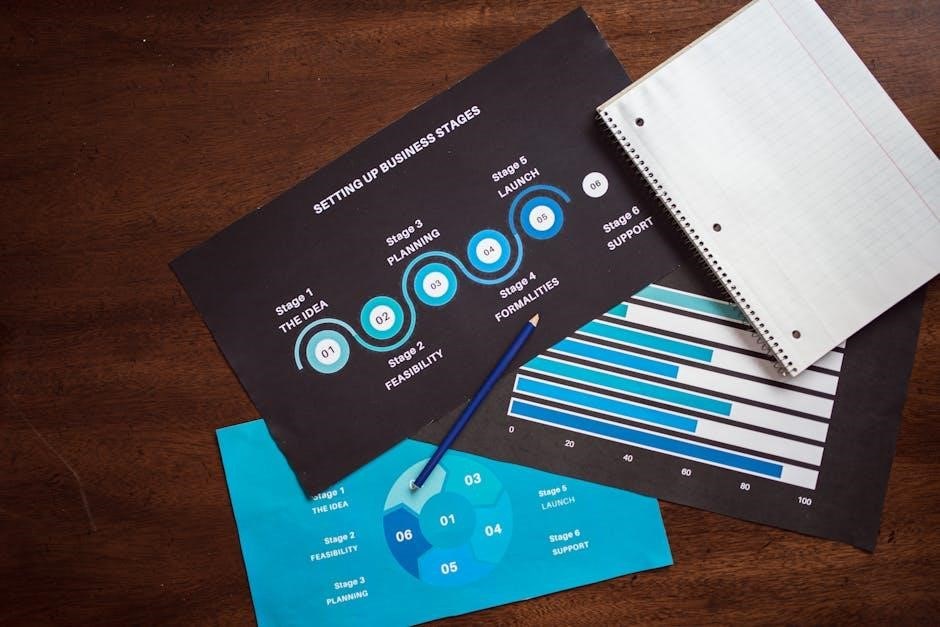Python is a powerful tool for data analysis, enabling efficient data handling and visualization. It supports various formats, including PDF, making it ideal for extracting and processing data from documents. Libraries like PyPDF2 and pdfplumber simplify PDF processing, allowing users to extract text, tables, and images seamlessly. Python’s versatility and extensive libraries make it a cornerstone in modern data analysis workflows.
- Python handles PDFs efficiently for data extraction.
- Libraries like PyPDF2 and pdfplumber streamline PDF processing.
- PDF support enhances data analysis capabilities in Python.
Why Python is Chosen for Data Analysis
Python is widely chosen for data analysis due to its simplicity, flexibility, and extensive libraries. Its intuitive syntax allows analysts to focus on logic rather than code complexity. Libraries like Pandas and NumPy provide efficient data manipulation and numerical operations, while Matplotlib and Seaborn enable robust visualization. Python’s versatility in handling various data formats, including PDFs, makes it a preferred choice for extracting and processing information from documents. Additionally, its large community and constant updates ensure it remains at the forefront of data science. Python’s ability to integrate with tools like Jupyter Notebooks further enhances its utility, making it a cornerstone in modern data analysis workflows.
- Intuitive syntax for focused data analysis.
- Extensive libraries for data manipulation and visualization.
- Efficient handling of PDFs for data extraction.
Key Libraries in Python for Data Analysis
Python’s strength in data analysis lies in its powerful libraries. Pandas is essential for data manipulation and analysis, offering data structures like DataFrames and Series. NumPy provides efficient numerical computation, enabling array-based operations. Matplotlib and Seaborn are crucial for data visualization, creating high-quality plots to communicate insights. PyPDF2 and pdfplumber are specialized for handling PDFs, allowing extraction of text, tables, and images. These libraries collectively enable Python to handle diverse data formats and perform complex analyses efficiently.
- Pandas: Core library for data manipulation and analysis.
- NumPy: Enables efficient numerical computations.
- Matplotlib/Seaborn: Tools for creating visualizations.
- PyPDF2/pdfplumber: Essential for PDF data extraction.
Python’s Role in the Data Science Ecosystem
Python is a cornerstone in the data science ecosystem, offering a comprehensive suite of tools that support every stage of the data science workflow. From data collection and cleaning to analysis, visualization, and reporting, Python provides libraries and frameworks that facilitate these processes. Libraries like Pandas and NumPy are essential for data manipulation and numerical operations, while Matplotlib and Seaborn enable the creation of visualizations that effectively communicate findings. Additionally, Python’s ability to handle various data formats, including PDFs, is enhanced by libraries like PyPDF2 and pdfplumber, which allow for the extraction of text and data from PDF documents. This adaptability, combined with a strong community and extensive resources, makes Python a central tool in data science, connecting different aspects of the workflow and supporting diverse datasets.
- Python supports all stages of the data science workflow.
- Libraries like Pandas and NumPy facilitate data manipulation and analysis.
- Matplotlib and Seaborn enable effective data visualization.
- PyPDF2 and pdfplumber handle PDF data extraction.
- Python’s versatility and community support make it indispensable in data science.

Setting Up the Environment for Data Analysis
Install Python and essential libraries like Pandas, NumPy, and Matplotlib. Configure Jupyter Notebooks for interactive analysis and use tools like PyPDF2 and pdfplumber for PDF data extraction.
- Install Python and required libraries.
- Set up Jupyter Notebooks for data analysis.
- Use PyPDF2 and pdfplumber for PDF processing.
Installing Python and Essential Libraries
To begin with Python for data analysis, install Python from its official website. Once installed, use pip to add essential libraries such as Pandas, NumPy, and Matplotlib. For PDF processing, install PyPDF2 and pdfplumber using pip. These libraries enable data extraction and manipulation from PDF files, which is crucial for analyzing data stored in this format. Ensure all installations are up-to-date for optimal performance. Additionally, consider installing Jupyter Notebooks for an interactive environment. These tools collectively provide a robust setup for handling and analyzing PDF data in Python.
- Install Python from the official website.
- Use pip to install Pandas, NumPy, and Matplotlib.
- Add PyPDF2 and pdfplumber for PDF processing.
- Update libraries regularly for the latest features.

Configuring Jupyter Notebooks for Data Analysis
Jupyter Notebooks provide an interactive environment for data analysis, especially when working with PDFs. To configure Jupyter Notebooks, install the Jupyter package using pip. Launch the notebook server by running `jupyter notebook` in your terminal. This opens a web interface where you can create and manage notebooks. For enhanced functionality, install additional kernels or extensions like JupyterLab. Configure your notebook to display visualizations inline by enabling the `%matplotlib inline` magic command. Organize your work by creating dedicated folders for projects involving PDF data analysis. Regularly update Jupyter and its extensions to ensure compatibility with libraries like Pandas and Matplotlib.
- Install Jupyter using `pip install jupyter`.
- Launch the notebook server with `jupyter notebook`.
- Enable inline visualizations with `%matplotlib inline`.
- Organize projects using folders and update tools regularly.

Working with Data in Python
Python simplifies data handling with libraries like Pandas and NumPy. Extracting data from PDFs is streamlined using PyPDF2 and pdfplumber, enabling efficient data manipulation and analysis.
- Pandas excels at data manipulation and analysis.
- NumPy optimizes numerical operations for performance.
- PyPDF2 and pdfplumber facilitate PDF data extraction.
Pandas is a powerful Python library designed for efficient data manipulation and analysis. It provides data structures like DataFrames and Series, enabling easy handling of structured data. With Pandas, you can merge, reshape, and analyze datasets effortlessly. Its integration with NumPy and Matplotlib enhances numerical operations and visualization capabilities. Pandas is particularly useful for data wrangling, making it a cornerstone in Python’s data analysis ecosystem. By leveraging Pandas, you can streamline data processing tasks, ensuring accurate and efficient data manipulation.
- Pandas offers DataFrames and Series for structured data handling.
- It supports merging, reshaping, and analyzing datasets.
- Integration with NumPy and Matplotlib boosts functionality.
- Pandas is essential for data wrangling and analysis.
Using NumPy for Numerical Operations
NumPy is the foundation of Python’s scientific computing ecosystem, providing efficient numerical operations. It introduces multi-dimensional arrays, enabling vectorized operations that outperform standard Python lists. NumPy is essential for handling large datasets, offering advanced mathematical functions and efficient data processing. Its integration with Pandas and Matplotlib makes it a cornerstone for data analysis. By leveraging NumPy, you can perform complex numerical computations with precision and speed, making it indispensable for scientific and engineering applications.
- NumPy provides multi-dimensional arrays for efficient data handling.
- Vectorized operations enhance performance for large datasets.
- Advanced mathematical functions simplify numerical computations.
- Integration with Pandas and Matplotlib streamlines data analysis workflows.

Data Visualization in Python
Python offers powerful libraries like Matplotlib and Seaborn for creating interactive and informative visualizations. These tools support various formats, including PDF, making it easy to export and share plots.
Matplotlib for Basic Data Visualization
Matplotlib is a foundational Python library for creating static, animated, and interactive visualizations. It excels at producing high-quality 2D plots, charts, and graphs, making it ideal for basic data exploration. With Matplotlib, users can generate line plots, bar charts, histograms, and more, customizing colors, fonts, and layouts. Its simplicity and flexibility make it a go-to tool for data analysts. Matplotlib also supports saving plots in various formats, including PDF, which is essential for sharing and publishing. Its integration with other libraries like Pandas ensures seamless data manipulation and visualization workflows.
- Creates high-quality 2D visualizations for data exploration.
- Supports various plot types, including line charts and histograms.
- Customizable styling for professional-grade outputs.
- Exports plots as PDF for easy sharing and reporting.
Advanced Visualization with Seaborn
Seaborn is a powerful Python library built on matplotlib, offering advanced data visualization capabilities. It provides elegant, high-level abstractions for creating informative and attractive statistical graphics. Seaborn excels at visualizing datasets with features like heatmaps, scatterplots, and regression plots. Its integration with Pandas DataFrames makes it ideal for exploring and understanding complex datasets. Additionally, Seaborn supports customization of themes, colors, and styles, enabling users to create professional-grade visualizations. For sharing and publication, Seaborn plots can be exported as PDF files, ensuring high-quality output. This library is particularly useful for advanced data analysis tasks, such as visualizing distributions, correlations, and trends in data.
- Creates sophisticated statistical graphics with ease.
- Supports advanced visualization types like heatmaps and pairplots.
- Customizable themes and styles for tailored outputs.
- Exports visualizations as PDF for professional use.


Handling PDFs in Python for Data Analysis
Python efficiently handles PDFs for data analysis, enabling text, table, and image extraction. Libraries like PyPDF2 and pdfplumber simplify data processing, making PDFs valuable in workflows.
Extracting Data from PDF Files
Extracting data from PDF files in Python is essential for analyzing information stored in documents. Libraries like PyPDF2 and pdfplumber enable users to extract text, tables, and images seamlessly. These tools handle complex layouts, ensuring accurate data retrieval. For instance, pdfplumber excels at identifying and extracting tabular data, while PyPDF2 offers robust text extraction capabilities. This makes Python a versatile solution for processing PDFs in data analysis workflows. The extracted data can then be manipulated using libraries like Pandas for further analysis. This integration highlights Python’s strength in handling diverse data formats, making it a reliable choice for extracting and analyzing PDF-based information efficiently.
Using PyPDF2 and pdfplumber for PDF Processing
PyPDF2 and pdfplumber are two powerful libraries for processing PDF files in Python. PyPDF2 is ideal for tasks like splitting, merging, and encrypting PDFs, while also supporting text extraction from individual pages or entire documents. On the other hand, pdfplumber excels at extracting structured data, such as tables and layouts, by analyzing the PDF’s visual structure. Both libraries complement each other, enabling comprehensive PDF processing. For instance, PyPDF2 can handle multi-page PDFs, while pdfplumber can extract complex tabular data. These tools are indispensable for data analysts working with PDF-based information, making Python a robust choice for PDF processing in data analysis workflows. Together, they streamline tasks like data extraction and manipulation, enhancing overall efficiency.

Case Studies and Applications

PyPDF2 and pdfplumber are essential for handling PDFs in Python. PyPDF2 allows merging, splitting, and encrypting PDFs, while also enabling text extraction. Pdfplumber excels at extracting structured data like tables and images. Together, they simplify PDF processing, making Python a robust tool for data analysis.
Real-World Examples of Python in Data Analysis
Python is widely utilized in various industries for data analysis involving PDF files. In finance, it is used to extract tables from financial reports to analyze market trends and performance metrics. Healthcare professionals employ Python to process patient records stored as PDFs, enabling efficient data analysis for better patient care. Academic researchers use Python to scrape data from research papers, facilitating meta-analysis and knowledge synthesis. Libraries such as PyPDF2 and pdfplumber are instrumental in these processes, offering robust tools for extracting structured data like tables and images from PDF documents. These real-world applications highlight Python’s efficiency and versatility in handling PDF data, making it an indispensable tool across multiple sectors.
